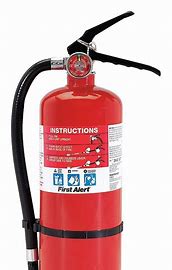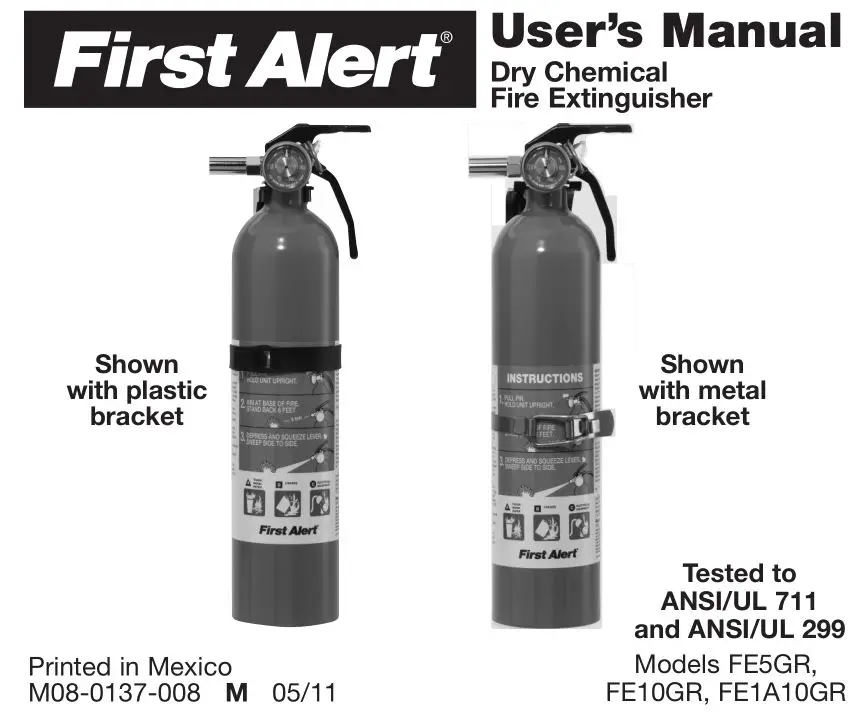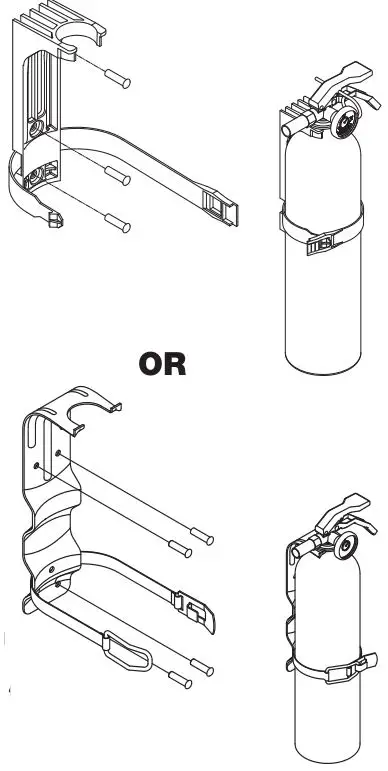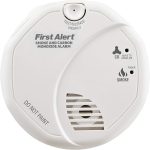
First Alert Dry Chemical Fire Extinguisher User Manual

IMPORTANT! Please read carefully and save.
This user’s manual contains important information about your fire extinguisher’s operation. If you are installing this fire extinguisher for use by others, you must leave this manual—or a copy of it—with the end user.
Read extinguisher label and the entire user’s manual carefully before installing or using the unit. Make sure everyone in your household is completely familiar with the operation of the extinguisher, and review the instructions regularly. In an emergency, you will not have time to read instructions.
© 2011 BRK Brands, Inc. All rights reserved.
Distributed by BRK Brands, Inc.
3901 Liberty Street Road, Aurora, IL 60504-8122
Consumer Affairs: (800) 323-9005 • www.firstalert.com
Thank you for choosing First Alert ® for your fire extinguisher needs. You have purchased a high quality fire extinguisher designed to protect you and your family in case of a fire danger.
IMPORTANT INFORMATION ABOUT FIRE EXTINGUISHERS
NOTE: Be sure the extinguisher is rated to fight the type of fire most likely to occur in the area you choose to install it. Since household fires commonly start in the kitchen, you should always install an extinguisher in the kitchen. For added security, you should also install additional extinguishers in utility areas, and other living areas in your household.
Fire extinguishers are classified by fire type. The A, B and C rating system defines the kinds of burning materials each fire extinguisher is designed to fight. The numbers in front of the A, B, or C indicate the rating for size of the fire the unit can extinguish. Using the wrong type of fire extinguisher can do more harm than good. Make sure you understand which fire extinguisher to use on each class of fire!

Class A rating: The agent/powder is suitable for fighting small fires involving wood, paper, cloth, rubber, and some plastics.
 Class B rating: The agent/powder is suitable for fighting small fires involving grease, oil, gasoline, kerosene, and other flammable liquids.
Class B rating: The agent/powder is suitable for fighting small fires involving grease, oil, gasoline, kerosene, and other flammable liquids.

Class C rating: The agent/powder is suitable for fighting small fires in “live” electrical equipment.
FE5GR is rated Class 5-B:C.
FE10GR is rated Class 10-B:C.
FE1A10GR is rated Class 1-A:10-B:C.
READ BEFORE INSTALLING OR USING THIS FIRE EXTINGUISHER!

DANGER
- This extinguisher is designed for use against small fires that have just started and are small enough to fight safely. It is not designed to fight large fires that are burning out of control. If the fire is too hot or smoky for you to get within 6 feet (2 meters) of it, do not try to fight it yourself. Warn everyone, evacuate the premises, and have someone call the Fire Department from outside the building. Trying to fight a large fire yourself can result in injury or death.
- Do not puncture or burn any fire extinguisher. The contents are under pressure, and the extinguisher could explode.
- Never locate this extinguisher close to an engine, stove or other source of heat. It is pressurized and could rupture or explode if exposed to temperatures over 150° F (66° C).

CAUTION!
- This extinguisher contains a dry powder extinguishing agent. The agent/powder is nontoxic, but can irritate skin. When using this unit, avoid breathing the powder. Always ventilate the area after use.
WHERE TO INSTALL THIS EXTINGUISHER
A Fire Extinguisher Should Be Mounted:
- In the vicinity of (but not on or in) a potential source of heat and/or fire, like an oven or stove.
- Where it is easy to reach, near an exit or an escape route from the room.
- In a location that is convenient, in plain sight, and 3-1/2 to 5 feet (1 to 1.5 meters) above the floor.
- Store the extinguisher high enough to keep it out of the reach of small children.
- On a clean, dry surface where the temperature does not go above 120° F (49° C) or below –40° F (–40° C).
HOW TO INSTALL THIS EXTINGUISHER

CAUTION!
- Do not mount the extinguisher on drywall or plaster without adequate support. Use strong screws or bolts to mount the bracket securely into solid wood or metal that can support it, like a wooden partition stud. Secure mounting is needed so you can remove the extinguisher quickly and easily in an emergency. Also, if the extinguisher is not held securely, it could drop to the floor and injure people or damage the extinguisher.
- DO NOT BREAK THE SAFETY SEAL! This seal prevents accidental discharge of the fire extinguisher. Break the seal only in an emergency before using the fire extinguisher.
INSTALL THE MOUNTING BRACKET ON A WALL

- The extinguisher has a bracket for wall mounting.
- Install the mounting bracket on a wooden stud or other solid surface that will support the weight of the extinguisher using the screws or bolts you purchased.
NOTE: Since wall surface types vary, mounting screws are not included. Purchase screws or bolts specifically designed for the surface on which you will mount the fire extinguisher. The fire extinguisher label lists its maximum weight. Mounting screw head type should be #8 pan on round head screws with #8 flat washers. - After installing the mounting bracket, replace the extinguisher on the bracket with the label facing outward, so the label can be easily read. Wrap the bracket strap around the cylinder and snap the buckle closed.
INSTALLING THE MOUNTING BRACKET IN A MARINE CRAFT
According to the NFPA Standard 302 (Fire protection Standard for Pleasure and Commercial Motor Craft):
- On marine craft, portable fire extinguishers shall be located to be readily accessible. Extinguishers shall be secured with a marine bracket to permit immediate release.
- On marine craft, extinguisher agent cylinders shall be mounted a minimum of 2 inches (5 cm) above moist or wet surfaces to reduce the danger of corrosion.
CHECKING AND INSPECTING THE FIRE EXTINGUISHER

WARNING!
- DO NOT CHECK THE PRESSURE OR TEST THE FIRE EXTINGUISHER BY SQUEEZING THE LEVER, EVEN BRIEFLY. ONCE USED, IT WILL GRADUALLY LOSE PRESSURE AND WILL NOT BE FULLY CHARGED FOR USE IN AN EMERGENCY.
- When the pointer drops into the red area, the extinguisher may still be pressurized, but must be recharged.
- Inspect the extinguisher once a week. Remove the extinguisher from the mounting bracket and inspect the gauge. If the yellow pointer is in the GREEN area, the extinguisher is properly pressurized and ready to use. If the pointer drops into the RED area, the extinguisher has lost some pressure and should be replaced.
- Check for signs of damage or misuse. Make sure you can still read all the text on the label. Carefully examine the surface of the extinguisher for corrosion. You can help prevent corrosion by cleaning the extinguisher if it gets wet or dirty. If you notice corrosion during the warranty period, return the unit to First Alert ® (see “Limited Warranty” at the end of this manual).
- Make sure the tamper indicator (“safety seal”) is still intact and the nozzle is clean and unobstructed.
- When you finish inspecting the extinguisher, always put it back securely into the mounting bracket.
IMPORTANT!
For more information about fire extinguishers, consult the NFPA Standard #10, “Portable Fire Extinguishers,” available from the National Fire Protection Association, Inc., Batterymarch Park, Quincy, MA 02169, USA.
HOW TO OPERATE YOUR FIRE EXTINGUISHER IN A FIRE EMERGENCY

DANGER
- Make sure your extinguisher may be safely and effectively used on the small fire you want to fight. Always use extreme caution when fighting any fire. Fight a fire only where there is a clear escape path to allow you to get out safely if the fire gets worse.

WARNING
- Avoid breathing smoke and heated fumes; stay low if necessary. Burning materials will release toxic fumes. Inhaling these fumes may cause injury or death.

CAUTION!
- Always stand back far enough away from the fire—near an exit—and make sure nothing is between you and your escape route. If you get too close to a fire, you risk getting burned or hit by splattering material like grease. If the fire is too hot or smoky for you to get within 6 feet (2 meters), DO NOT try to fight the fire yourself. Evacuate immediately and call the Fire Department.
- For fires on a kitchen stove, turn oven or burners off immediately if possible. If you can’t reach the oven or burner controls safely, extinguish the fire first, then turn them off.
- Fight the fire from an upwind direction with your back to any strong air current. Trying to fight a fire with currents blowing towards you can result in serious injury.
TO FIGHT THE FIRE

- Remove the extinguisher from the mounting bracket.
- Hold the unit firmly with the nozzle facing away from you. Pull out the pin to break the “Safety Seal”. You won’t be able to squeeze the lever until the safety seal is removed.
- Stand back 6 feet (2 meters) from the fire and make sure the fire is not between you and your exit.
- Hold the extinguisher upright and aim the nozzle at the base of the fire.
- Squeeze and hold the lever to discharge the powder.
- Sweep the spray at the base of the burning material, using quick side-to-side motions. (If the spray scatters the fire, move back.)
- Move slowly towards the fire as the extinguisher spray pushes the fire back. Maintain a 6-foot (2 meter) distance between you and the front of the fire at all times.
- Completely discharge the contents of the extinguisher and make sure the fire is completely out. Flashbacks are common with fires.
- For kitchen fires on a kitchen stove, turn off the stove immediately if possible, otherwise as soon as it is safe.
- If you suspect a fire had an electrical origin, shut off the electrical power, if possible, without eliminating your escape route. Do not touch electrical wires or appliances.
- After you have completely discharged your extinguisher, leave the building and close all the doors behind you.
AFTER THE FIRE IS EXTINGUISHED

DANGER
Do not turn the electrical power back on or plug in any appliances until the area has been cleaned up completely. It is very important to remove the powder from electrical equipment after a fire. If the powder gets wet, it can conduct electricity. (Using a dry chemical extinguisher on wet electrical equipment may be hazardous for this reason.) This may worsen an electrical leakage problem, impair the equipment’s insulation, or create an electrical shock hazard.
If the fire was on a kitchen stove:
- Make sure the oven and all burners are turned off.
- Clean up the powder completely before using the stove or oven. See “How to Clean After Using a Fire Extinguisher”. Ventilate the area thoroughly.
If you think the fire had an electrical origin:
- Shut off the electrical power, if possible–do not touch any electrical wires or appliances.
- Leave the building and close all doors behind you. Call the Fire Department and have them inspect the premises. As soon as they say it’s safe to return, ventilate the area thoroughly.
- Have a licensed electrician inspect your electrical system. Do not turn the power back on or plug in any electrical equipment until the inspection has been completed.
HOW TO CLEAN AFTER USING A FIRE EXTINGUISHER
NOTE: The powder spray from the extinguisher may spread over a wide area, and may soil upholstery, carpets and walls.
- Sweep/vacuum up as much of the powder as possible. Then use a damp cloth to wipe off the remaining agent.
- If you have any questions about cleaning appliances that the agent has come into contact with, please contact the appliance manufacturer.
IF YOUR EXTINGUISHER NEEDS SERVICE
This fire extinguisher is rechargeable by a certified fire equipment dealer, regardless of how much of the content was used.
Once a year, a certified fire equipment dealer, in accordance with the service manual identified on the fire extinguisher label, should service the fire extinguisher. Please refer to your local telephone directory for a certified dealer.

CAUTION!
Do not try to service or repair this fire extinguisher under any circumstances. Do not try to remove the nozzle or valve assembly. This is a pressurized device that can cause serious injury if tampered with.
If there is a problem and it is still under warranty, please see “How to Obtain Warranty Service” in the Limited Warranty.
DISPOSING OF A USED EXTINGUISHER
If you choose not to have a used extinguisher refilled or a non-working unit repaired, take it outdoors, turn it upside down, and discharge it completely. Dispose of the empty unit properly, and replace it with a new fire extinguisher.

DANGER
Never puncture, burn or expose this fire extinguisher to temperatures over 150° F (66° C) even if it is fully discharged. The contents are under pressure and it could explode.
LIMITED WARRANTY
BRK Brands, Inc. (“BRK”) the maker of First Alert ® brand products, warrants that for a period of ten years from the date of purchase, this product will be free from defects in material and workmanship. BRK, at its option, will repair or replace this product or any component of the product found to be defective during the warranty period. Replacement will be made with a new or remanufactured product or component. If the product is no longer available, replacement may be made with a similar product of equal or greater value. This is your exclusive warranty.
This warranty is valid for the original retail purchaser from the date of initial retail purchase and is not transferable. Keep the original sales receipt. Proof of purchase is required to obtain warranty performance. BRK dealers, service centers, or retail stores selling BRK products do not have the right to alter, modify or any way change the terms and conditions of this warranty.
This warranty does not cover normal wear of parts or damage resulting from any of the following: negligent use or misuse of the product, use on improper voltage or current, use contrary to the operating instructions, disassembly, repair or alteration by anyone other than BRK or an authorized service center. Further, the warranty does not cover acts of God, such as fire, flood, hurricanes and tornadoes.
BRK shall not be liable for any incidental or consequential damages caused by the breach of any express or implied warranty. Except to the extent prohibited by applicable law, any implied warranty of merchantability or fitness for a particular purpose is limited in duration to the duration of the above warranty. Some states, provinces, or jurisdictions do not allow the exclusion or limitation of incidental or consequential damages or limitations on how long an implied warranty lasts, so the above limitations or exclusion may not apply to you. This warranty gives you specific legal rights, and you may also have other rights that vary from state to state, or province to province.
How to Obtain Warranty Service
Service: If service is required, do not return the product to your retailer. In order to obtain warranty service, contact the Consumer Affairs Division at 1-800-323-9005, 7:30 AM to 5:00 PM, Central Standard Time, Monday through Friday. To assist in serving you, please have the model number and date of purchase available when calling.
Address: 25 Spur Drive, El Paso, TX 79906
Marine Type, U.S.C.G. Type B:C, Size I
U.S.C.G. Approval Number 162.028/EX3622
Valid only with Bracket Number P87-0340 or Bracket Number B70-0161 and Strap Number S70-0007. Bracket included.
First Alert ® is a registered trademark of the First Alert Trust.
